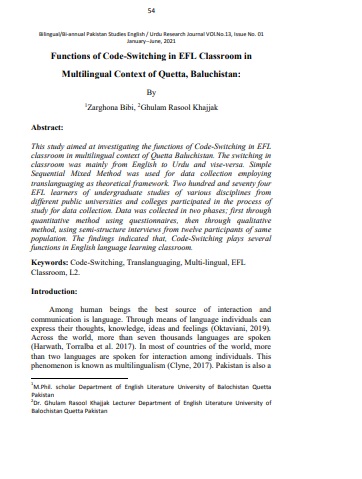Functions of Code-Switching in EFL Classroom in Multilingual Context of Quetta, Baluchistan
Keywords:
: Code-Switching, Translanguaging, Multi-lingual, EFL Classroom, L2.Abstract
This study aimed at investigating the functions of Code-Switching in EFL
classroom in multilingual context of Quetta Baluchistan. The switching in
classroom was mainly from English to Urdu and vise-versa. Simple
Sequential Mixed Method was used for data collection employing
translanguaging as theoretical framework. Two hundred and seventy four
EFL learners of undergraduate studies of various disciplines from
different public universities and colleges participated in the process of
study for data collection. Data was collected in two phases; first through
quantitative method using questionnaires, then through qualitative
method, using semi-structure interviews from twelve participants of same
population. The findings indicated that, Code-Switching plays several
functions in English language learning classroom.
References
Al-Qaysi, N. J. M. (2016). Examining Students' and Educators' Attitudes
Towards the use of Code Switching within Higher Educational
Environments in Oman (Doctoral dissertation, The British
University in Dubai (BUiD)).
Braun, V., & Clarke, V. (2006). Using thematic analysis in psychology.
Qualitative Research in Psychology, 3(2), 77-101.
Cahyani, H., de Courcy, M., & Barnett, J. (2018). Teachers‟ CodeSwitching in bilingual classrooms: Exploring pedagogical and
sociocultural functions. International Journal of Bilingual
Education and Bilingualism, 21(4), 465-479.
Clyne, M. (2017). Multilingualism. The Handbook of Sociolinguistics,
-314.
Creswell, J. W. (1999). Mixed-method research: Introduction and
application. In Handbook of Educational Policy (pp. 455-472).
Academic Press.
Dörnyei, Z. (2003). Attitudes, orientations, and motivations in language
learning: Advances in theory, research, and applications. Language
learning, 53(S1), 3-32.
Fareed, M., Humayun, S., & Akhtar, H. (2016). English language
teachers‟ Code-Switching in class: ESL learners‟ perceptions.
Journal of Education & Social Sciences, 4(1), 1-11.
Gulzar, M., A. (2010). Code-Switching: Awareness about its utility in
bilingual classrooms. Bulletin of Education and Research, 32(2),
-44.
Gulzar, M., S. (2017). Teachers‟ code-switching in a content-focused
English as a second language (ESL) classroom: Patterns and
Functions (Doctoral dissertation).
Gumperz, J., J. (1982). Discourse strategies (No. 1). Cambridge
University Press.
Harwath, D., Torralba, A., & Glass, J. R. (2017). Unsupervised learning of
spoken language with visual context
Hinton, P., Brownlow, C., McMurray, I., & Cozens, B. (2004). SPSS
explained Routledge. Inc, East Sussex, England.
Lin, A. M. (2008). Code-switching in the classroom: Research paradigms
and approaches. Encyclopedia of Language and Education, 10,
-286.
Marshall, G., & Jonker, L. (2010). An introduction to descriptive statistics:
A review and practical guide. Radiography, 16(4), e1-e7.
Obaidullah, M. (2016). Code switching in EFL classrooms: A Bangladeshi
perspective. Theory and Practice in Language Studies, 6(5), 924.
Oktaviani, A. (2019). An analysis of using code switching on listening
subject of student‟s English department of Iain metro in academic
year of 2018/2019 (Doctoral dissertation, IAIN
Metro).
Park, M. S. (2013). Code-Switching and translanguaging: Potential
functions in multilingual classrooms.
Pratapa, A., Bhat, G., Choudhury, M., Sitaram, S., Dandapat, S., & Bali,
K. (2018, July). Language modeling for Code-Mixing: The role of
linguistic theory based synthetic data. In Proceedings of the 56th
Annual Meeting of the Association for Computational Linguistics
(Volume 1: Long Papers) (pp. 1543-1553).
Rahman, T. (2008). Language policy, multilingualism and language
vitality in Pakistan. In Lesser known languages of South Asia (pp.
-106). De Gruyter Mouton.
Rauf, A. (2018). Students‟ attitude towards teachers‟ use of Codeswitching and its impact on learning English. International Journal
of English Linguistics, 8(1), 212-218.
Vogel, S., & García, O. (2017). Translanguaging.
Wei, L. (2018). "Translanguaging as a practical theory of language”.
Applied linguistics 39(1), 9-



